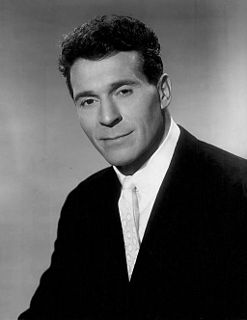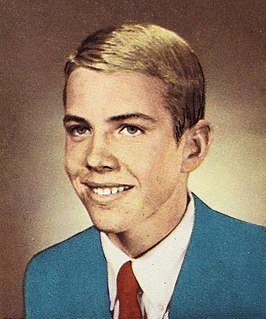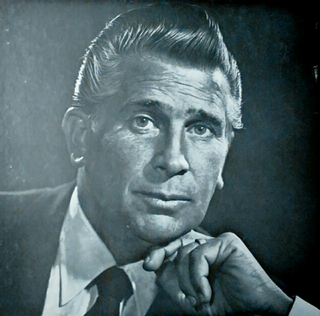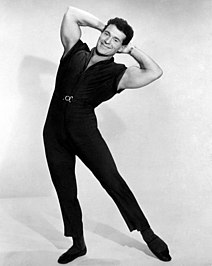Synchronised swimming or artistic swimming is a hybrid form of cheerleading, swimming dance, and gymnastics, consisting of swimmers performing a synchronized routine of elaborate moves in the water, accompanied by music. Synchronised swimming is governed internationally by FINA, and has been part of the Summer Olympics programme since 1984.

A jumping jack, also known as a star jump and called a side-straddle hop in the US military, is a physical jumping exercise performed by jumping to a position with the legs spread wide and the hands going overhead, sometimes in a clap, and then returning to a position with the feet together and the arms at the sides.

The butterfly is a swimming stroke swum on the chest, with both arms moving symmetrically, accompanied by the butterfly kick. While other styles like the breaststroke, front crawl, or backstroke can be swum adequately by beginners, the butterfly is a more difficult stroke that requires good technique as well as strong muscles. It is the newest swimming style swum in competition, first swum in 1933 and originating out of the breaststroke.

Breaststroke is a swimming style in which the swimmer is on their chest and the torso does not rotate. It is the most popular recreational style due to the swimmer's head being out of the water a large portion of the time, and that it can be swum comfortably at slow speeds. In most swimming classes, beginners learn either the breaststroke or the freestyle first. However, at the competitive level, swimming breaststroke at speed requires endurance and strength comparable to other strokes. Some people refer to breaststroke as the "frog" stroke, as the arms and legs move somewhat like a frog swimming in the water. The stroke itself is the slowest of any competitive strokes and is thought to be the oldest of all swimming strokes.

Backstroke or back crawl is one of the four swimming styles used in competitive events regulated by FINA, and the only one of these styles swum on the back. This swimming style has the advantage of easy breathing, but the disadvantage of swimmers not being able to see where they are going. It also has a different start from the other three competition swimming styles. The swimming style is similar to an upside down front crawl or freestyle. Both backstroke and front crawl are long-axis strokes. In individual medley backstroke is the second style swum; in the medley relay it is the first style swum.
Human swimming typically consists of repeating a specific body motion or swimming stroke to propel that body forward. There are many kinds of strokes, each defining a different swimming style or crawl.

Francois Henri "Jack" LaLanne was an American fitness and nutrition guru and motivational speaker. He described himself as being a "sugarholic" and a "junk food junkie" until he was age 15. He also had behavioral problems, but "turned his life around" after listening to a public lecture about the benefits of good nutrition by health food pioneer Paul Bragg. During his career, he came to believe that the country's overall health depended on the health of its population, and referred to physical culture and nutrition as "the salvation of America."

Michael Groß, usually spelled Michael Gross in English, is a former competitive swimmer from Germany. He is 201 centimetres tall, and received the nickname "The Albatross" for his especially long arms that gave him a total span of 2.13 meters. Gross, competing for West Germany, won three Olympic gold medals, two in 1984 and one in 1988 in the freestyle and butterfly events, in addition to two World Championship titles in 1982, two in 1986 and one in 1991.

Gary Wayne Hall Sr. is an American former competition swimmer, three-time Olympic medalist, and former world record-holder in five events.
Maurice A. Catarcio was an American professional wrestler. He was best known for competing in the then World Wide Wrestling Federation from 1957 to 1960, under the ring-name The Matador. After being diagnosed with prostate cancer in 1991, he became an advocate for public health and fitness. He was also in The Guinness Book of World Records for his public displays of strength.

Adolph Gustav Kiefer was an American competition swimmer, Olympic competitor, the last surviving gold medalist of the 1936 Summer Olympics and former world record-holder. He was the first man in the world to swim the 100-yard backstroke in under one minute. Kiefer was also an inventor and innovator of new products related to aquatics competition.

Diana Nyad is an American author, journalist, motivational speaker, and long-distance swimmer. Nyad gained national attention in 1975 when she swam around Manhattan and in 1979 when she swam from North Bimini, The Bahamas, to Juno Beach, Florida. In 2013, on her fifth attempt and at age 64, she became the first person claiming to have swum from Cuba to Florida without the aid of a shark cage, swimming from Havana to Key West although this has not been formally ratified by any recognised swim body. Nyad was also once ranked thirteenth among US women squash players.
Deforrest "Moe" Most was a gymnast and the unofficial "ambassador" of Muscle Beach.

The following outline is provided as an overview of and topical guide to exercise:

Victor "Vic" Tanny was an American bodybuilder, entrepreneur and physical culture advocate. He is considered a pioneer of the modern health club.
The men's 400 metre individual medley event at the 2000 Summer Olympics took place on 17 September at the Sydney International Aquatic Centre in Sydney, Australia.
Combat side stroke or CSS is a variation of the side stroke that was developed by and taught to the United States Navy SEALs. The Combat Swimmer Stroke was developed for the United States Navy Seals by Former Navy SEAL Stew Smith (CSCS) and Terry Laughlin of Total Immersion Swimming.
The Aquatots was the name given to two American children, Russell "Bubba" Tongay and his sister Kathy Tongay, due to their ability to perform daring swimming feats at a very young age.

The Jack LaLanne Show was an American exercise television show hosted by Jack LaLanne that ran from 1951 to 1985.

The L Street Brownies are a polar bear club based in South Boston, Massachusetts. Organized in 1902, it is one of the oldest such clubs in the United States. Although the Brownies swim year round, they are best known for their annual New Year's Day plunge in Dorchester Bay.













